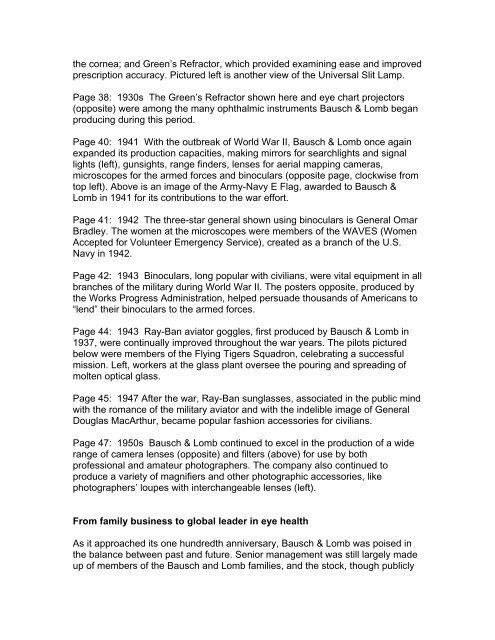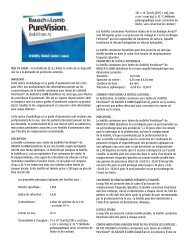Bausch & Lomb Perfecting vision, enhancing life for 150 years A ...
Bausch & Lomb Perfecting vision, enhancing life for 150 years A ...
Bausch & Lomb Perfecting vision, enhancing life for 150 years A ...
You also want an ePaper? Increase the reach of your titles
YUMPU automatically turns print PDFs into web optimized ePapers that Google loves.
the cornea; and Green’s Refractor, which provided examining ease and improved<br />
prescription accuracy. Pictured left is another view of the Universal Slit Lamp.<br />
Page 38: 1930s The Green’s Refractor shown here and eye chart projectors<br />
(opposite) were among the many ophthalmic instruments <strong>Bausch</strong> & <strong>Lomb</strong> began<br />
producing during this period.<br />
Page 40: 1941 With the outbreak of World War II, <strong>Bausch</strong> & <strong>Lomb</strong> once again<br />
expanded its production capacities, making mirrors <strong>for</strong> searchlights and signal<br />
lights (left), gunsights, range finders, lenses <strong>for</strong> aerial mapping cameras,<br />
microscopes <strong>for</strong> the armed <strong>for</strong>ces and binoculars (opposite page, clockwise from<br />
top left). Above is an image of the Army-Navy E Flag, awarded to <strong>Bausch</strong> &<br />
<strong>Lomb</strong> in 1941 <strong>for</strong> its contributions to the war ef<strong>for</strong>t.<br />
Page 41: 1942 The three-star general shown using binoculars is General Omar<br />
Bradley. The women at the microscopes were members of the WAVES (Women<br />
Accepted <strong>for</strong> Volunteer Emergency Service), created as a branch of the U.S.<br />
Navy in 1942.<br />
Page 42: 1943 Binoculars, long popular with civilians, were vital equipment in all<br />
branches of the military during World War II. The posters opposite, produced by<br />
the Works Progress Administration, helped persuade thousands of Americans to<br />
“lend” their binoculars to the armed <strong>for</strong>ces.<br />
Page 44: 1943 Ray-Ban aviator goggles, first produced by <strong>Bausch</strong> & <strong>Lomb</strong> in<br />
1937, were continually improved throughout the war <strong>years</strong>. The pilots pictured<br />
below were members of the Flying Tigers Squadron, celebrating a successful<br />
mission. Left, workers at the glass plant oversee the pouring and spreading of<br />
molten optical glass.<br />
Page 45: 1947 After the war, Ray-Ban sunglasses, associated in the public mind<br />
with the romance of the military aviator and with the indelible image of General<br />
Douglas MacArthur, became popular fashion accessories <strong>for</strong> civilians.<br />
Page 47: 1950s <strong>Bausch</strong> & <strong>Lomb</strong> continued to excel in the production of a wide<br />
range of camera lenses (opposite) and filters (above) <strong>for</strong> use by both<br />
professional and amateur photographers. The company also continued to<br />
produce a variety of magnifiers and other photographic accessories, like<br />
photographers’ loupes with interchangeable lenses (left).<br />
From family business to global leader in eye health<br />
As it approached its one hundredth anniversary, <strong>Bausch</strong> & <strong>Lomb</strong> was poised in<br />
the balance between past and future. Senior management was still largely made<br />
up of members of the <strong>Bausch</strong> and <strong>Lomb</strong> families, and the stock, though publicly






